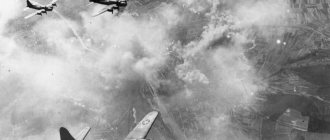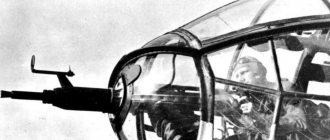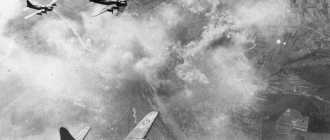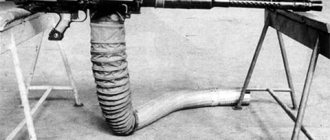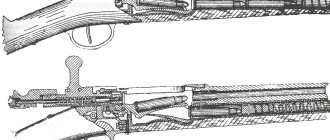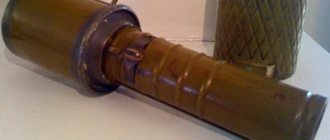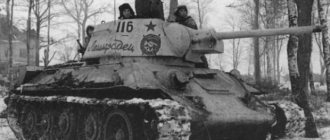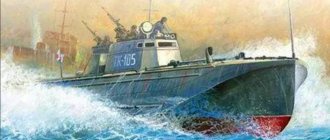Author: Sergey
27 March 2015 18:08
Tags: war history facts
14947
13
1
Based on your few requests, I am continuing the topic. As we all already know from my previous post. The best submachine gun at that time was the PPS-43, and not the MP-40 or PPSh. In this topic we will not destroy existing myths - you already know him. However, everything is in order.
0
See all photos in the gallery
It is difficult to overestimate the role that machine guns played in history. Including in the history of our country. From the moment of their appearance in service with the Russian Army to the present day, machine guns have undergone a complex evolution. Suffice it to remember that at the beginning of the twentieth century they were still considered as a special weapon with a very narrow range of combat missions, and in the middle of it they already permeated the entire organization of troops and still remain one of the most important means of fire destruction of the enemy in close combat, and have long become an integral weapon combat vehicles, aircraft and ships. The Red Army most often dealt with these machine guns during World War II. I’m omitting the performance characteristics - they are of little interest to anyone.
7.62 mm light machine gun DP-27
0
The DP light machine gun (Degtyarev, infantry) was adopted by the Red Army in 1927 and became one of the first models created from scratch in the young Soviet state. The machine gun turned out to be quite successful and reliable, and was widely used as the main weapon of fire support for infantry of a platoon-company link until the end of the Great Patriotic War. At the end of the war, the DP machine gun and its modernized version DPM, created based on the experience of combat operations in 1943-44, were removed from the arsenal of the Soviet Army, and were widely supplied to countries and regimes “friendly” to the USSR, having been noted in the wars in Korea, Vietnam and others. The DP light machine gun is an automatic weapon with automation based on the removal of powder gases and magazine feed. The gas engine has a long stroke piston and gas regulator located under the barrel. The barrel itself is quick-change, partially hidden by a protective casing and equipped with a conical removable flash suppressor. The return spring was located under the barrel and, under intense fire, overheated and lost its elasticity, which was one of the few disadvantages of the DP machine gun. The food was supplied from flat disk magazines - “plates”, in which the cartridges were arranged in one layer, with bullets towards the center of the disk. This design ensured reliable supply of cartridges with a protruding rim, but also had significant drawbacks: large dead weight of the magazine, inconvenience in transportation and the tendency of magazines to be damaged in combat conditions. (Why wasn’t a box magazine used for the DP, similar to that used in the English Bren RP, also created for rimmed cartridges, although Degtyarev developed a similar power supply circuit for the experimental RP of 1938?) The machine gun’s trigger allowed only automatic fire. There was no conventional safety; instead, an automatic safety was located on the handle, which turned off when the hand covered the neck of the butt. The fire was fired from fixed folding bipods.
Machine guns of the German army during WWII
Many experts specializing in the field of small arms consider German machine guns to be the best of those used in World War II. In this case, we are usually talking about machine guns MG 34 and MG 42.
The MG-34 machine gun was adopted by the Wehrmacht in 1934. It was the main machine gun until 1942 in both the Wehrmacht and tank forces. A special feature of the design is the ability to switch power to feed the tape both from the left and from the right, which is very convenient for use in armored vehicles. For this reason, the MG-34 was used in tank forces even after the appearance of the MG-42. The disadvantage of the design is the labor and material consumption of production, as well as sensitivity to contamination.
MG-34 machine gun
An unsuccessful design among German machine guns was the HK MG-36. The relatively light (10 kg) and easy-to-manufacture machine gun was not reliable enough, the rate of fire was 500 rounds per minute, and the box magazine contained only 25 rounds. As a result, it was first armed with Waffen SS units, supplied on a residual basis, then it was used as a training weapon, and in 1943 it was completely withdrawn from service.
HK mg36 machine gun
The masterpiece of German machine gun engineering is the famous MG-42, which replaced the MG-34 in 1942. Compared to the MG-34, the designers were able to reduce the cost of the machine gun by approximately 30%, and the metal consumption by 50%.
MG-42 machine gun - “Hitler Circular”
Production of the MG-42, nicknamed “Hitler's circular machine,” continued throughout the war; in total, more than 400 thousand machine guns were produced. The machine gun's unique rate of fire made it a powerful means of suppressing the enemy, however, as a result, the MG-42 required frequent replacement of barrels during combat. At the same time, on the one hand, changing the barrel was carried out structurally in 6-10 seconds, on the other hand, it was possible only with the presence of heat-insulating (asbestos) mittens or any improvised means.
In the case of intense shooting, it was necessary to change the barrel every 250 shots: if there was a well-equipped firing point and a spare barrel, or better yet two, everything was great, but if it was not possible to change the barrel, then the effectiveness of the machine gun dropped sharply, firing could only be carried out in short bursts and taking into account the need for natural cooling of the barrel. The MG-42 is deservedly considered the best machine gun in its class of World War II.
The Mauser MG-81 machine gun of the 1939 model was also used to a limited extent by the Germans. Initially, the MG-81 was used as an on-board defensive weapon for Luftwaffe bombers; it began to enter service with airfield divisions in 1944. The short barrel length caused a lower muzzle velocity compared to standard light machine guns, but the MG-81 had less weight.
But for some reason the Germans did not bother with heavy machine guns in advance. Only in 1944 did the troops receive Rheinmetall-Borsig MG-131 machine guns of the 1938 model, which are also of aviation origin: when the fighters were converted to 30-mm MK-103 and MK-108 air guns, the MG-131 heavy machine guns were transferred to the ground forces (total 8132 machine guns).
Rheinmetall-Borsig MG-131 machine gun
Thus, we can say that in general, from a design point of view, the Reich and the USSR had parity in machine guns. On the one hand, the MG-34 and MG-42 had a significantly higher rate of fire, which in many cases was of great importance. On the other hand, they required frequent barrel changes, otherwise the rate of fire remained theoretical.
In terms of maneuverability, the old “Degtyarev” won: the inconvenient disk magazines nevertheless allowed the machine gunner to fire alone.
7.62 mm heavy machine gun DS-39
0
The heavy machine gun (DS-39) is an automatic firearm of the V.A. system. Degtyarev, developed in the USSR and adopted by the Red Army in 1939. History of creation. The heavy weight and technological complexity of the Maxim system heavy machine gun forced work to create a new, lighter and simpler heavy machine gun. This work was carried out in the Soviet Union since the end of the 20s. Their result was the adoption in September 1939 of the Red Army of a 7.62-mm heavy machine gun of the Degtyarev system mod. 1939 Its development was started by Vasily Alekseevich Dyagtyarev at the beginning of 1930, and already at the end of 1930 he presented the first sample for field testing. After identifying a number of shortcomings, the machine gun was sent for modification, which mainly affected only the tape feed mechanism. In 1934, the modified machine gun was presented for field tests, which lasted from November 1934 to June 1938. During the tests, several changes were made to the design of the machine gun: the pistol grip was replaced with butt plate handles, two firing modes were made, the the position of the reciprocating mainspring, the barrel ribbing appeared, the universal machine I.N. Kolesnikov was replaced by a lighter machine, developed by Dyagtyarev. This version of the machine gun was adopted by the Red Army on September 22, 1939. The machine gun had the abbreviated designation “DS-39” (Degtyarev easel). The production of the machine gun began at the Kovrov plant, but then moved to the Tula arms plant, which had previously produced heavy machine guns of the 1910 model. As development progressed, the production of DS-39 at TOZ gradually increased, and the production of Maxims decreased accordingly and by 1940 completely stopped. In total in 1940 - 1941. 10,345 DS-39 machine guns were produced. Descriptions of the device Automation of a machine gun works by removing part of the powder gases from the barrel bore. The barrel bore is locked when firing by moving the lugs apart. The trigger mechanism allows only automatic fire in two modes - 600 and 1200 rpm, and the second firing mode was intended for firing at air targets. Switching fire modes occurs by turning the handle of the buffer device, which is located below, on the back side of the receiver. The belt feeder is of a slider type, the slider moves along a curved groove, the belt with cartridges is fed from the right side (later this belt feeding mechanism was used in the DShK machine gun). The charging handle is located on the right side of the weapon's receiver. There are two triggers, they are located in front of each buttplate handle; during shooting, they were pressed simultaneously with the index fingers. The spent cartridges were thrown down. Its characteristic feature is air cooling of the barrel. The diameter of the cooling fins decreases from the gas chamber to the muzzle of the barrel along a cone. During intense shooting, the barrel was replaced with a spare one; to avoid burns to the hands when replacing it, it has a special handle. A frame-type sight with scales for shooting light and heavy bullets. The tripod machine has a mechanism for precise vertical guidance.
Single machine guns of the USSR
It is no secret that, in addition to the well-known types of weapons that are adopted by the army and law enforcement agencies, there are also a lot of little-known and sometimes completely forgotten models. The holding of various competitions, the purpose of which was the adoption of one or another representative of a particular class of weapons, has already been covered in detail in countless articles. But, despite this, Soviet single machine guns have received little attention. From the moment the very idea of creating material on this topic appeared, it remained a mystery to me why this happened and everyone stubbornly does not want to raise this layer of the history of domestic weapons, but as I searched for information, the answer came by itself.
Despite the fact that at the moment any information is available on the Internet, there is virtually no data on single machine guns of the Soviet Union. Of course, there are references, which are most often taken from printed publications, but there are simply no detailed descriptions, distinctive features, and even weight and size characteristics for most models. Accordingly, there seems to be nothing to write about, which explains the absence of such articles.
Despite the scarcity, and sometimes complete lack of information, I will try to at least minimize the gaps in this area, and perhaps this article will become a catalyst for a more detailed study of the issue by other authors who have greater opportunities to search for information. Unfortunately, I cannot claim that this article will be complete and detailed, but I will try to collect in one place the data that I was able to find.
Domestic single machine gun. Start
Even in the comments under the article about German single machine guns, a small debate broke out about where and when the idea of a single machine gun came from. It is difficult to convince someone and change an opinion that has already formed over the years, especially since the argument: “if it is not written “single”, then it is not one” is ironclad. I am starting from the very idea of using a machine gun, both with a bipod and on a machine with a single design, and Fedorov was the first to propose such a proposal on the territory of present-day Russia. The concept of a single machine gun does not exclude the possibility of using this weapon on armored vehicles, in aviation, twin anti-aircraft guns, and so on; if all this can be implemented without changes in the design of the weapon, then this is only a “plus”.
One can argue that virtually any machine gun chambered for a rifle cartridge can be equipped with a bipod or mounted on a machine, which, of course, will not make it “single”. Vladimir Grigorievich Fedorov initially proposed a design that would allow the machine gun to be used as a manual, easel, or aircraft one. Anyone who says that this is different from the concept of a single machine gun can throw a stone or two at me.
But there is no need to rush to select heavier cobblestones, here is an excerpt from the conclusion of Artkom based on the results of tests of samples proposed by Fedorov dated May 31, 1923: “The new project of engineer Fedorov for converting a machine gun into a machine gun with water and air cooling is of undoubted interest, since the implementation of such a project would give the opportunity to obtain all types of automatic weapons based on the same system, the installation of which has already been carried out, which would present enormous benefits both in terms of the uniformity of production in factories and in relation to the training of Red Army soldiers"
. And already in 1926 they were developed on a single basis: a self-loading rifle and its shortened version (carbine), an assault rifle, three versions of light machine guns, on their basis a tank machine gun, aviation machine guns (including coaxial and triple), a light and heavy machine gun . All this diversity appeared, also thanks to the fact that Fedorov began working with the well-known Degtyarev.
To say that the idea itself is to use the same design to close “holes” in weapons and in general this is a forced measure is not at all correct. Not all countries can afford to have different models in service for specific tasks, and even those that can afford it, for some reason, do not do so. Savings can be different, forced and planned, but they do not cease to be savings, and it is savings that are the reason for the creation of such a subclass of weapons as a single machine gun.
Despite this, it is difficult to argue with the fact that a full-fledged single machine gun has not been in the country’s arsenal for quite a long time. If the primacy of the idea originated on the territory of the USSR, then its implementation began after the end of the Second World War.
Usually in such a situation they immediately begin to look for those to blame, but it is easy to judge this now from our time. It’s easy to talk about what needed to be done with a mug of coffee in a comfortable chair, relying on the experience of others, including the experience of foreign designers. In this case, it should be noted that the first single machine gun, which was adopted for service and which was produced en masse, was created in Germany, and it was after the German troops showed the effectiveness of this weapon that other countries began to seriously think about a similar subclass of machine guns . Actually, the same story happened with the class of weapons that we usually call machine guns. The idea was there a long time ago, but implementation arrived after the weapon demonstrated its effectiveness in another army. So, looking for someone who slowed down the emergence of a single machine gun in the army’s arsenal is a pointless exercise.
Garanin machine gun model 1947
After the end of the Great Patriotic War, the GAU formed tactical and technical requirements, which became the basis for future unified machine guns. Usually, the countdown from the creation of a domestic single machine gun to the adoption of the PC begins in 1953, with the Nikitin machine gun, which is not entirely true, or rather not at all true. According to the requirements that were originally formulated by the GAU, the first machine gun was created back in 1947 by Georgy Semenovich Garanin.
The basis for the weapon was an automatic system with removal of powder gases from the barrel bore; the barrel bore was locked by turning the bolt by two stops. Ammunition was supplied directly from an open belt. The machine gun was presented for testing with an attached bipod, as well as on machines in wheeled and tripod versions.
The test result was not the best, or rather, a failure. The weapon had a lot of shortcomings, the main one of which was frequent failures when supplying ammunition. The weapon received the rating “Further work on this machine gun is impractical,” but despite this, the feasibility of adopting a single machine gun was once again noted, and in addition, the requirements for the new weapon were adjusted.
Single machine gun Nikitin-Sokolov TKB-521
This single machine gun is quite well-known and has been written about more than once; it is this weapon that will subsequently become a competitor to the Kalashnikov machine gun, but there were years left before the final of this fight, and the Nikitin-Sokolov machine gun itself was born in 1953, two years before the official start of the competitive race.
This weapon is also interesting because the then young and unknown designer Yuri Mikhailovich Sokolov took part in its creation, and his participation was very direct, which is sometimes forgotten when calling the machine gun a Nikitin machine gun. According to Grigory Ivanovich himself, the young designer was not just present, but contributed to the design of the trigger, automation system, barrel design, in a word, he was fully involved in the work on the project.
The basis of the automation of the Nikitin-Sokolov machine gun was the system for removing powder gases from the barrel bore with a shut-off valve for powder gases, which subsequently affected the results of the competition. The barrel bore was locked by turning the bolt. It was interesting to organize the feeding of the cartridge from the belt into the chamber, which was direct, despite the presence of a rim on the ammunition. Removing the cartridge from the belt was realized using a lever, which, when the bolt group moved, “snapped” the cartridge from the tape.
At the first stage of the competition, the Nikitin-Sokolov machine gun showed more than decent results, leaving behind the designs of the new Garanin 2B-P-10 machine gun and Silin-Perushev TKB-464 in 1956. However, during further tests, in 1958, a serious drawback of the new weapon was revealed, which had not previously been given any importance.
In order to ensure uniform pressure of the powder gases on the piston of the bolt frame, the designers used a cutoff of the powder gases. This gave the weapon stability in operation, but had its own set of typos on operating conditions. Thus, the weapon, being immersed in water, after being removed from it, refused to fire automatically. The shooter had to cock the bolt several times in order for automatic fire to become available again. It would seem that the shortcoming is more than minor and one could turn a blind eye to it, since the army neither then nor now has underwater machine gun crews, and is not expected to do so. However, the new weapon was planned to be actively used on armored vehicles, so contact with water could not be excluded; accordingly, such delays, although in a rare form, could be present in the weapon in the future.
This was the only serious drawback of the Nikitin-Sokolov machine gun, which did not allow it to win the competition. In terms of the totality of its other characteristics, the weapon was at the level of the Kalashnikov machine gun, and in some respects it was even slightly superior to it, but the designers failed to solve the problem outlined above.
Single Garanin 2B-P-10 machine gun
Having not made the most successful start, Georgy Semenovich Garanin did not abandon the idea of creating a single machine gun of his own design. So by 1956, he provided his machine gun under the designation 2B-P-10 for testing.
This time, the automatic weapon was built according to a semi-blowback design; unfortunately, it was not possible to find reliable information about the implementation of braking of the bolt group, since various sources have different opinions on this issue. There is often information about the use of a modified bolt group, similar to that of the German MG-42 machine gun, but since there is not a single image of the 2B-P-10 bolt, it is hardly worth talking about authenticity. On the other hand, the designer used a direct ammunition supply system, but this time the weapon had no problems with feeding.
The main problems of the weapon were low accuracy and its sensitivity to contamination. The latter, in general, is not surprising with a semi-open bolt, especially considering that the machine guns were also tested “dry”, wiped clean of lubricant. According to the test results, Garanin's new machine gun failed again and again further work on this design was considered inappropriate.
Single machine gun Silin-Peruschev TKB-464
This machine gun is another one that is usually only mentioned, but does not go into detail, and in fact there are not many details. The designers decided to use the Goryunov machine gun, which had already been well mastered in production, as the basis for the new machine gun, which to some extent could ensure the success of the weapon and tip the scales in its favor when choosing between models with identical characteristics. However, this sample dropped out of the competition due to the rupture of ammunition casings during feeding.
The basis of the machine gun's automation was an automatic system with the removal of powder gases from the barrel bore, while the barrel bore was locked when the bolt was skewed to the side.
It is not entirely clear why the designers were unable to establish a normal supply of ammunition when using the same belt from the Goryunov machine gun, and what specific problems arose in this case. Even more questions are raised by the fact that this machine gun design was considered unpromising and further work on it inappropriate, although bringing such a design to acceptable levels would provide a tangible financial advantage if adopted.
Shilin AO-29 machine gun
Further - less. Virtually nothing is known about this machine gun except its weight of 6.7 kilograms, the fact that it consisted of 96 parts and that the spent cartridge case is thrown forward and down.
It is obvious that the automatic weapon is built on the removal of powder gases from the barrel, and there is nothing more to say about the design of the machine gun just by appearance. It can be assumed that the weapon must have had some unique features in its design, especially considering that Tkachev is often cited as the co-author of this design. You can also find information about co-authorship with Lyubimov, which is doubtful, since this designer was involved in work on another project for a single machine gun. In any case, this machine gun is a big blank spot in the history of the creation of the domestic single machine gun, although, it would seem, not much time has passed for such spots to form.
Gryazev-Lubimov-Kastornov AO-22 machine gun
This machine gun is another unknown weapon with a complete lack of information on it, but it is of even greater interest due to the design features that are visible even from one image of the machine gun. In particular, what is striking is that the design of the machine gun contains an annular piston, which is pushed by powder gases. At the same time, one can only guess how the weapon implemented a quick replacement of the barrel, how it reacted to overheating of the barrel, and so on.
By the way, it is usually believed that this arrangement of the chamber for removing powder gases for machine guns and machine guns is not the best solution, however, there are references to such weapons as the AO-22M. So there is a slight hint of further development of the design of this machine gun, which means it was decided that the design has potential, since they tried to develop it in the future. It is worth noting that it is not entirely clear when exactly the modernized weapon was presented, before the adoption of the PC or later.
Single Garanin 2B-P-45 machine gun
Let's return to the more famous types of weapons, although information on them is quite scarce. Two failures with the wording about the futility of the design did not stop Garanin; the designer proposed his third version of the machine gun, which in its design was not similar to the previous two. It is impossible not to notice that, if we take the totality of the work done, then Georgy Semenovich did a much larger volume than other designers, although this work went unnoticed.
The new machine gun was already based on automation with the removal of powder gases from the barrel, locking was carried out when the bolt was turned. The power was supplied from the belt of the Goryunov machine gun, and the ejection of spent cartridges was carried out downwards. Obviously, the designer did not have enough time to bring his latest version of the weapon to the final stage of the competition, which led to the absence of his machine gun among the finalists.
In general, one cannot help but notice that the main problem that the designer faced was the inability to bring his weapon to acceptable characteristics and satisfactory performance. In both the first and second cases, the samples were demonstrated in a very crude form and clearly could not impress the commission, and therefore work on the designs stopped and each time they had to start all over again. Even without the opportunity to study information from the designer’s own memories about the environment in which the work was carried out, we can say with confidence that haste was to blame for everything.
By the way, it can be noted that in almost every competition for new weapons for the Soviet army, one can single out a designer who persistently moved forward, despite constant failures. Now it is fashionable to raise the topic of unrecognized geniuses, but, in most cases, the refusal to new weapon models was quite justified, as was clearly demonstrated with Garanin’s single machine guns. Nevertheless, the amount of work and determination of Georgy Semenovich inspires only respect.
How a single Kalashnikov machine gun won
You can talk about the Kalashnikov machine gun long and hard, repeating everything that was written earlier, and despite the fact that this machine gun won the competition, which means it was better than its competitors, it no longer arouses such interest, since it has become familiar and known to everyone.
At the final stage of the competition, the PC competed with TKB-521. It is noteworthy that back in 1958, a decision was made to mass produce Nikitin-Sokolov machine guns, but Mikhail Timofeevich joined the fight, violating these plans. Work on the new machine gun was started clearly later than other competitors, however, Kalashnikov had wider capabilities, at least in the form of a resource of already quite experienced employees of the design bureau. One might even say that to some extent the conditions were not entirely equal. For the final of the competition, a sample of a weapon was provided, which in its characteristics, if not superior, was equal to the Nikitin-Sokolov machine gun, and, perhaps, the final result of the competition would have had to be postponed after additional tests, but the TKB-521 was let down by the design feature of the powder gas removal unit . After the machine guns were immersed in water, the Kalashnikov machine gun worked flawlessly immediately after removal, while the Nikitin-Sokolov machine gun habitually refused to fire in bursts after water procedures, requiring several shots with manual reloading. This was the reason for losing the competition.
In addition, Mikhail Timofeevich himself recalled that during the testing process another unpleasant incident was associated with the Nikitin-Sokolov machine gun. During the tests, one of the shooters fired a shot without resting the butt on the shoulder, for which he received this same butt in the face, earning a bruise to that same face. Whether this should be attributed to weapons is a controversial issue. Given the use of identical ammunition and a similar automation system, it is very doubtful that the recoil between the PC and the TKB-521 could vary significantly. Rather, this is a matter of chance, and conclusions about a more comfortable recoil of a weapon when firing can only be made by those who participated in those tests.
Thus, in 1961, a new single machine gun, developed under the leadership of Kalashnikov, was adopted by the Soviet army.
Single machine gun Nikitin TKB-015
But the rivalry between Nikitin and Mikhail Timofeevich did not end with the victory of the single machine gun, developed under the leadership of Kalashnikov, just as the history of Soviet single machine guns did not end. In 1969, a modernized PC appeared, and with it, its main competitor, the Nikitin TKB-015 machine gun, appeared.
This time, although the designer used automation using part of the powder gases removed from the barrel to reload the weapon, he refused the cutoff, so now in theory the weapon should not be afraid of swimming. The highlight of the new machine gun was the bolt group. The barrel bore was locked using a wedge mechanism, while the swinging bolt earring, at the moment the bolt frame passed into the forward position, hit the firing pin, which initiated the shot. This sounds very familiar, especially to those familiar with the design of the NSV machine gun. It was from TKB-015 that this decision migrated, which once again suggests that the designer’s work, even if his weapon is not accepted for service, does not just happen.
As tests have shown, both machine guns showed almost identical results, with alternating slight advantages, but it is not difficult to guess that for economic reasons the victory was given to the PKM. Since the production of weapons had already been established, there was no point in mastering the production of new weapons with similar characteristics, which were still unknown how they would perform in the series. At that time, it was necessary to provide something out of the ordinary, which was difficult to do if identical ammunition was used.
The weight of the TKB-015 machine gun was 6.1 kilograms. The total length was 1085 millimeters with a barrel length of 605 millimeters.
PCM and its development
As with the first version of the Kalashnikov machine gun, which won the competition for the first single machine gun for the Soviet army, it is pointless to say anything about the PKM, since everything that could be said has already been said. This is a reliable weapon with its advantages and disadvantages, and judging by the distribution and recognition by foreign experts, the PKM clearly has more advantages than disadvantages.
At its core, the PKM machine gun is a Serbian-made Zastava M84 machine gun, the only difference from the original weapon is the stock. They tried to repeat the design of the PKM in the original version in China under the designation Type 80, however, this happened after modernization, as a result the weapon received the designation Type 86.
PKM became the basis for the further development of domestic weapons, in particular the single Pecheneg machine gun, however, this is no longer a Soviet development, although, of course, very interesting, thanks, so to speak, to the active ventilation of the weapon barrel due to the difference in atmospheric pressure at the muzzle and receiver. Of no less interest is the Badger machine gun, also known as AEK-999, which, in addition to a new barrel and certain technical solutions, also has a device for reducing the sound of a shot (PBS is hard to name). This was implemented primarily not so much to provide camouflage for the machine gun crew when firing, but to ensure comfort during the use of weapons by reducing the sound of a weapon being fired. Despite the fact that this machine gun is often called silent, this, of course, is not the case, although the volume of the shot does indeed decrease significantly.
In other words, the weapon proved its right to exist not only by winning competitions, but also by becoming a platform for the creation of new models, which are based on the same design with additions and minor changes. As is often noted on many specialized Internet resources, the Kalashnikov machine gun will leave the army only if the 7.62x54 is removed from service, although at the same time, it seems to me, weapons will be developed based on it, unless the cartridge is replaced with something fundamentally new.
Conclusion
In conclusion, I would like to share my doubts about the fact that when the PKM was adopted, only the Nikitin TKB-015 machine gun competed with it. Obviously, there should have been other examples of single machine guns, but they are not even mentioned.
You should also not miss another interesting fact. At the first competition for a single machine gun for the Soviet army, a “foreign guest” was also present, namely the Czechoslovak machine gun UK vz. 59 designs by Antonin Foral. This machine gun was indeed very good for its time, and it really could compete with the samples presented at this competition, but, of course, one could not count on victory.
One cannot ignore another moment in the history of the appearance of the domestic single machine gun. Degtyarev also worked on a single machine gun of his own design, and he began work on the weapon as one of the first domestic gunsmiths, at the same time as Garanin, but Vasily Alekseevich never finished his work, as he died on January 16, 1949.
Once again, I would like to note that this article does not pretend to fully cover the issue; it is rather a compilation of the small portion of information that is currently available in various sources. Obviously, there is a lack of not only a description of the individual components of the weapon, but also their weight and size characteristics. So, if any of the readers have access to such data, then posting them in the comments is only welcome; perhaps, through joint efforts, it will be possible to eliminate the gaps in this rather extensive layer of the history of domestic small arms.
Sources of information and photos: bratishka.ru raigap.livejournal.com warspot.ru zonwar.ru forum.guns.ru airwar.ru otvaga2004.ru kalashnikov.ru arsenal-info.ru super-arsenal.ru
7.62 mm heavy machine gun SG-43
0
The machine gun was developed by P. M. Goryunov, put into service in 1943 and began to be supplied to the troops to replace the Maxim and Degtyarev DS-39 heavy machine guns. The Goryunov machine gun was put into service in 1943 under the name “7.62-mm heavy machine gun of the Goryunov system mod. 1943 (SG-43)." It appeared in the middle of World War II, at the most tragic time for the USSR, when there was a catastrophic shortage of machine guns on the fronts. Thanks to its simplicity and manufacturability, it had a significant impact on the course of military operations with the power of its fire, reliability, and maneuverability. The industry quickly mastered its production, closed the gap in the army's armament and made it possible to create a strategic reserve of machine guns. However, one important detail should be noted in the fate of the SG-43 machine gun. It appeared in service with the Russian army thanks to V.A. Degtyarev and his high consciousness of civic duty. This is how D. N. Bolotin describes this story. "AND. V. Stalin kept under his control the development of a new heavy machine gun. He personally knew Degtyarev, trusted him, believed in his talent and did not allow the thought that anyone could surpass him, and therefore gave instructions to take the Degtyarev DS-30 machine gun as the basis for the development of a new heavy machine gun. Every effort was made to develop such a machine gun. Goryunov, together with master V.E. Vorotnikov and his nephew, mechanic M.M. Goryunov, developed his machine gun optionally, in semi-legal conditions. In competitive tests, in which the improved Degtyarev machine gun and a number of foreign models took part, the Goryunov machine gun turned out to be the best. This contradicted Stalin’s instructions, therefore, at the final meeting, when he asked Degtyarev which machine gun was better, Degtyarev stated that Goryunov’s machine gun was simpler and more reliable than his machine gun, industry would master it faster, and therefore Goryunov’s machine gun should be adopted for service. So the army received excellent weapons.” The machine gun was mounted on a Degtyarev wheeled machine or on a Sidorenko-Malinovsky machine. Both machines allowed firing at ground and air targets. The SGT tank machine gun was developed on the basis of the SG-43 machine gun. During military operations, a number of shortcomings were identified in the machine gun. And therefore the machine gun was modernized. The following changes were made: the design of the trigger mechanism was changed; removed the shield from Degtyarev’s wheeled machine; introduced the Malinovsky-Sidorenko tripod machine. The machine gun received the SGM index. The automatic machine gun operates using the energy of powder gases removed from the barrel through a side hole. The barrel bore is locked by turning the bolt. The striker-type trigger mechanism allows only continuous fire. Open-type sighting devices consist of a frame sight and a front sight. When turned on, the lever-type safety locks the trigger mechanism. The machine gun is fed with cartridges from a metal belt with 250 rounds of ammunition, consisting of 5 links of 50 rounds each. It is allowed to use canvas tape from a Maxim machine gun.
7.92 mm light machine gun ZB-26/30/37
0
In the early 20s. XX century In Czechoslovakia, after it gained independence in 1919, industrial development began at a rapid pace. In Brno, for the purpose of designing and producing various types of small arms, a. One of the company's first developments was a belt-fed machine gun, designated ZB mod. 24. The machine gun was designed by Vaclav Holek in accordance with the terms of the competition for the creation of a light machine gun held in 1924 by the Czechoslovak army. The tactical and technical characteristics of the weapon presented by Kholek turned out to be higher than those of machine guns of other systems that participated in the competition. The command of the Czechoslovak army decided to adopt the Holek machine gun on the condition that the belt feed (which, by the way, worked flawlessly during tests) was replaced with power supply through a box magazine installed on the receiver. According to the military, the use of food from the magazine contributed to the mobility of the machine gun on the battlefield. The new model of the machine gun received the designation “model 24”, and after launching into mass production it was designated ZB mod. 26. This light machine gun immediately gained popularity among the troops. In addition to the army of Czechoslovakia, quite large quantities of these machine guns were received by the armies of China, Yugoslavia and Spain. In addition, deliveries were made to another 22 countries around the world. In 1930, a more advanced model appeared - ZB mod. 30. At first glance, both machine guns were completely identical. Arr. 30 was distinguished only by its production technology and some external details, in particular the presence of a gas regulator. This machine gun was adopted by the Romanian army. In 1933, testing of the ZCB-33 modification, created for the English 7.71 mm rifle cartridge, began in England. This machine gun was adopted by the British army under the name Bren. The automatic machine gun of this modification works on the principle of removing part of the powder gases from the barrel, for which purpose a gas chamber with a regulator is located under the barrel in the front part. The barrel bore is locked by skewing the bolt in a vertical plane using corresponding inclined surfaces on the bolt frame post and on the bolt. The trigger mechanism involves firing both single shots and bursts. Switching the fire mode is carried out by a flag-type translator located on the left side of the trigger guard. The translator also functions as a safety device. The machine gun has an air-cooled barrel, and to improve cooling conditions the barrel is equipped with ribs. There is also the possibility of quickly replacing an overheated barrel, for which a handle is attached to the barrel, which is also used when carrying the machine gun. There is also a bipod or a light machine with which you can fire at aircraft (an anti-aircraft sight is used, the rear sight of which is installed on the left side of the receiver, and the front sight is on the tide of the guide tube). The standard sight of the machine gun provides targeted shooting at a range of up to 1600 m. It consists of a front sight and a trailer drum on which marks are applied. Each division corresponds to a change in range by 100 m. Mauser rifle cartridges are used for firing a machine gun. The cartridges are fed from a box magazine with a capacity of 20 or 30 rounds. After the occupation of Czechoslovakia, the production of ZB-26/30 machine guns continued for the needs of the Wehrmacht. It should be noted that during the Second World War, this machine gun was widely used on both sides of the front and established itself as a reliable and unpretentious weapon. The SA came into close contact with the ZB in 1944, during the liberation of Eastern Europe: Yugoslavia, Czechoslovakia, Poland, etc.

